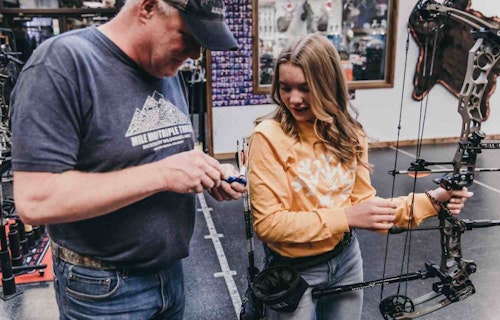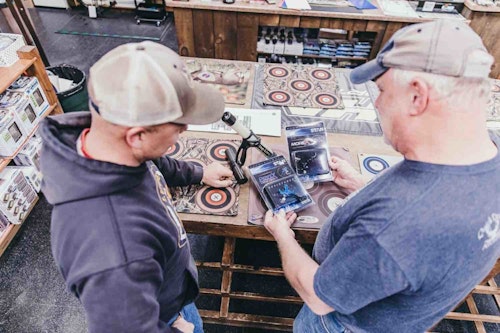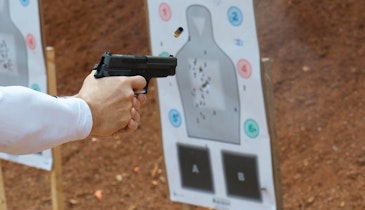Let me begin here: A release aid is one of archery’s most important accessories. Think about it. It serves as the vital connection point between the archer and the bow, and it plays an irreplaceable role in the complex shot-execution process. If you understand that, good, but I still suggest reading on for some solid input from noted experts, which I’ll get to in just a few moments. Now, if you’ve been understating the importance of release aids when you sell them to your customers, this article will help you think differently and become a better steward of your customers in the release-sales category.
Archery shops that don’t place enough importance on releases sort of generalize their customers. That is, when any given customer asks the “expert” behind the counter what to buy, all are directed to the same index-finger release. Just like suggesting that 3,500 calories is the ideal daily intake for every single human being on the planet, outfitting every customer with the same index-finger release can restrict some archers from achieving their accuracy potential. So, if you’ve been suggesting only one or two releases to everyone, please take the following paragraphs into consideration. Believe me, your customers will benefit greatly from your extra attention to detail.
To overview what’s ahead, I’ve divided the information into index-finger and handheld categories so you can easily digest it. The subject matter comes from pro shop owner, archery coach and three-time Wisconsin state archery champion Gary Hintz of Bucks & Bulls Archery, which is located in Stevens Point, Wisconsin. Hintz coaches kids as young as 6 to shoot release aids — often hinge or tension-activated releases — properly using back tension. But, I won’t stop with his input. I also discussed release aids with renowned tournament archer, bowhunter and shooting coach John Dudley of Nock On Archery. Let’s review some points that the two shared with me.


While any release aid can work across all archery activities, some lend themselves toward better performance in specific contexts. So, before you approach a sales presentation, learn your prospective customer’s primarily use for a new release.
“When a customer comes in to buy a release, I first ask them what style of archery they plan to shoot,” Hintz said. “I specifically want to know if they’re shooting leagues, competing in tournaments, or bowhunting. Some release styles are better geared for bowhunting, while other styles complement the target archer. I also get to know their budget. Some index-finger releases are very affordable, while some handhelds can be pricey.”
Beyond application, it’s important to remember that a customer should generally shoot what he or she is comfortable with, so long as they can shoot it with the proper muscles mechanics and without target panic.
“The style of release an archer should shoot really comes down to the individual archer’s preference,” Dudley explained. “The key is to choose one that allows you to shoot an arrow without anticipating shot. This is the most important statement I can make: You must shoot without ‘making your shot happen.’ Arrows take time to leave the bow — they aren’t as fast as bullets — so anticipation and punching the trigger can result in poor impact.
“Another key is having a release that you can get comfortable with as your sight pin floats around on a target. You need to be able to trust that float while you are slowly pulling through the shot until the bow lets the arrow fly with a complete surprise.”
Index-Finger Releases
As I mentioned earlier, certain release styles lend themselves toward certain archery categories. For bowhunters, an index-finger release is the most common and accepted, but there are exceptions.
“For customers who strictly bowhunt, I most often match them with index-finger releases,” Hintz explained. “I sell dozens of TruFire index-finger releases. People really like the fold-back feature for hunting. We also sell some Cobra and Scott index-finger releases. We have options from low-end to high-end, so we can offer every customer something. I find that bow buyers tend to match their release (price-wise) to the bow they’re buying. For example, if someone buys a high-end bow, they usually buy a high-end release, too.
“Sure, some target archers start out with an index-finger release. Sooner or later, though, I try to talk them into some sort of a back-tension release. Again, it’s the bowhunters who primarily go with index-finger releases.”
Dudley shared his input on archery’s most common release style.
“Some folks really prefer a wrist strap because of habit, and because it’s the preferred kind of release for archery,” he explained. “What most people find with an index-finger release is the index finger itself has been trained over their entire life to poke things and flip switches. Also, forced shots with firearms require the shooter to pull or hit the trigger. With archery, however, this simply doesn’t work. Very quickly, it develops into ‘hitting’ the trigger as your pin floats near the spot you want to hit. Even worse, some folks freeze their pin underneath the target, then forcibly jerk the bow upward and hammer the release simultaneously. Fostering this bad cycle will increase your anxiety during the shot and hold you back from your potential.”
What Dudley is getting at is an index-finger release isn’t a good option for someone who is currently shooting one, has target panic and is punching the trigger. In this case, switching them to a handheld of some sort can help them to relearn the shot-execution process and achieve the surprise release that Dudley says is critical. Of course, the release alone won’t cure them. You’ll have to teach them how to properly shoot whatever release they purchase.

Handhelds
Target panic is a real issue that afflicts untold numbers of archers. In fact, most archers deal with it at some point in their life. Even Dudley and champion archer Levi Morgan have admittedly experienced it during their long and successful careers. Hintz also had it so bad at one point in his life that he couldn’t even get his pin on the target.
“Target panic is something that so many people struggle with at one point or another,” Hintz said. “Most often it’s with an index-finger release. They’re punching it by habit, and when they’re looking for a way out, they tend to gravitate toward a thumb-activated release. A thumb release can help, but there are right and wrong ways to shoot one.
“I spend some time explaining to my customers the technique of wrapping the thumb around the trigger and then using back-tension to build pressure on it and execute the shot. I spend this extra time with them because it can be easy to punch a thumb release, and that won’t help their target panic. Shot correctly, though, a thumb release can help them break the cycle.”
Dudley agrees that changing to a different release style is a positive step to overcoming target panic.
“Tons of people shoot a wrist-strap release the wrong way or at least have bad habits with it,” he stated, “so learning a new hand position or with a different finger on the trigger allows you to erase old habits. Many archers have gravitated to handheld releases because they’re new, and relearning with one means adopting a better shot. The release style itself isn’t necessarily more accurate; different release types are all equally accurate if shot properly. With handheld releases of any style, archers often find that they’re retraining themselves to pull though the shot better with a perfect surprise.”
There are three basic types of releases in the handheld category: hinge, thumb-activated and tension-activated. Hinge and thumb-activated styles can easily be cheated or shot with incorrect mechanics. The tension-activated release really hammers home the concept of pulling through the shot using back tension.

“Most high-level archers, gold medalists and elite pros shoot handheld releases and use back tension as a method of pulling through the shot,” Dudley shared. “Years ago when training national teams, I determined that a release that fires simply by pulling slightly harder against the string while at full draw helps people understand the ‘surprise shot.’ Over the years, I worked with designers to make a release that fires simply from tension or resistance. We make two models: One is the Silverback handheld release, and we also have a wrist-strap option called the Back Strap.
“Additionally, Nock On Archery has other handheld release styles. One has thumb-trigger activation, which fires simply when the thumb adds pressure to the trigger. The other is the hinge-style release that has no trigger system, but simply fires when the release is rotated slightly, causing the hook that holds the string to flip open like a trap door. When shot properly, all Nock On Archery releases can give an archer the shot they’re looking for. Still, I believe that someone who knows they’re struggling with target panic or forcing the trigger to go off will be much better off learning the right way with a tension-activated release. You can find plenty of online videos on Nock On Archery’s YouTube channel to learn the surprise shot.”
Besides the way the different release types shoot, Dudley advises that anchoring correctly differs from one release to another.
“If someone is trying a handheld release for the first time, the best advice I can offer is to do some homework on how to properly anchor with a handheld release versus with a wrist-strap release,” he said. “A great YouTube video resource I created that can really help break this down is ‘Mastering the Release Aid.’”
As Dudley mentioned previously, a tension-activated release can really help an archer learn the surprise-shot technique. Hintz agrees.
“I coach a lot of archers of all ages, but I especially mentor a lot of young archers,” Hintz said. “I usually start them out with a tension-activated release so they really develop the back-tension technique and the muscle memory that goes with it. As they become older, some graduate into a hinge release. When they do, I teach them how to shoot it correctly, because there are right and wrong ways to shoot a hinge. A lot of people don’t realize it, but you can definitely cheat a hinge release to fire. It’s important for anyone to learn the correct way to avoid developing bad habits.
“This is so important that I teach customers how to shoot a hinge at only about 5 yards until they’re acclimated. I don’t want them to miss the entire target if they accidentally misfire. The good thing about the Stan hinges I sell is they have a safety mechanism. As for hinge brands, most of my customers shoot a Stan because I do. For those who cannot afford a Stan, I offer some TruFire hinges that are about $100 cheaper.
“Still, for someone switching to a different release due to target panic, I usually direct them toward a tension-activated release. You can’t cheat it as easily as you can a thumb or hinge release. I teach my customers to fire it by pulling and rotating their shoulder blade associated with the release hand.”

Final Thoughts
It’s detrimental to lump most customers together and suggest just one or two releases to virtually everyone. You should learn your customers’ preferences, and if they’re struggling with target panic. In this case, putting them into a different style of release is smart. Some might lean toward a thumb-activated release, and while that style of release certainly feels different and fires by way of a different finger, it also can be slapped. You might save the customer some frustration and put them into a tension-activated release, which Dudley and Hintz agree is the ideal release aid for learning a true surprise release.
Nock On Archery has many resources you and your customers can dig into for sound release tips. Be sure to visit their YouTube channel to see how the three handheld releases function and the best way to use each one. (To get started, check out “What Nock On Release Is Right for Me.” Other favorites of mine are “Mastering the Release Aid” and “Learning the Release Aid.”) Between this article and these videos, you should have a better grip on how to match your customer with the right release aid and also teach them how to shoot it correctly.





